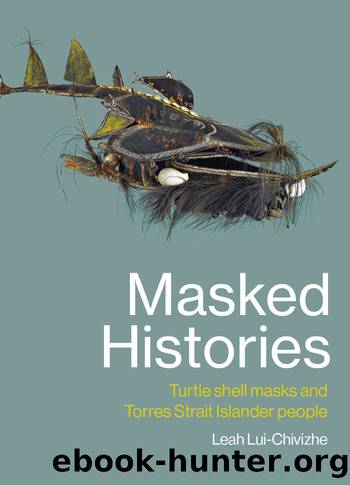Masked Histories: Turtle Shell Masks and Torres Strait Islander People by Leah Lui-Chivizhe

Author:Leah Lui-Chivizhe [Lui-Chivizhe, Leah]
Language: eng
Format: epub
Tags: History, Australia & New Zealand, Social Science, Sociology, General, Art, Crafts & Hobbies
ISBN: 9780522877960
Google: E4xyEAAAQBAJ
Publisher: MelbourneUP
Published: 2022-07-05T20:33:38+00:00
Womer Masks, Mabuyag
The womer (W) or waumer (E) (frigatebird, Fregata species) features prominently on two large masks collected from Mabuyag in the mid-1880s. Found across the tropical regions of the Indian and Pacific oceans, the womer is known by fisherpeople for signalling the presence of shoals of fish close to the surface of the ocean. Its forked tail and angular wings give it a striking and distinctive profile when in flight, and its use of thermal wind currents enables it to hover for long periods. As with turtle and the surlal, across the Torres Strait the womer is associated with kuki/koki (north-west monsoon). During the strong winds and rough seas of kuki/koki, the womer are plentiful and fly high above the squalling winds. The womer also has totemic significance to people of Mabuyag, where Waria noted it as a totem animal to Wagedugam. In the Mer Island, the waumer is a totem of the Giar Pit clan of Dauar island. Representations of the waumer are ubiquitousâit is found on dance staves, carved on canoes and its feathers are a feature of dari headdresses.30
On both masks (Mask 6; Mask 7) womer are portrayed in flight, their outstretched wings of turtle shell stitched together with finely made vegetable twine. They âhoverâ above the helmet-shaped base, held in place by thin pieces of bamboo. On both masks, the birdâs head is made of wood, painted black, and the eyes are chiselled into the wood and ochred in red. The beaks are a lighter colour than the head and are incised to show the line of the beak and the slight downward curve of the tip. On the front edge of the wings of both masks are two discs of turtle shell with white lime inlay. The human faces on both masks have thin, sharp angular noses and close-set mother of pearl eyes with beeswax pupils. The turtle shell faces have been polished to a smooth sheen and a thin band of etching borders the edge of the face. Along the outer edge of each face are attached pieces of turtle shell with incised chevron patterning, a common feature of turtle shell masks.
The National Museum of Scotland records show the womer mask (Mask 6) was acquired by the Museum on 5 August 1885. The Museum had purchased the mask for £6 from Edward Gerrard, a private taxidermist who also worked as a clerk at the British Museum.31 The mask was among those taken from Mabuyag by the Reverend Samuel McFarlane and shipped via Gerrard to Augustus W Franks at the British Museum. Not everything McFarlane sent to Gerrard was purchased by the British Museum and it appears this mask was either sold at auction or offered to the National Museum of Scotland in 1885.32 The mask remains part of the Museum of Scotland collections, where its significance is acknowledged based on its rarity and the period of its collecting.33
Its twin mask (Mask 7) was also collected by Samuel McFarlane and is in the collection of the Metropolitan Museum of Art, New York.
Download
This site does not store any files on its server. We only index and link to content provided by other sites. Please contact the content providers to delete copyright contents if any and email us, we'll remove relevant links or contents immediately.
The Memory Code by Lynne Kelly(2356)
Schindler's Ark by Thomas Keneally(1832)
Kings Cross by Louis Nowra(1753)
Burke and Wills: The triumph and tragedy of Australia's most famous explorers by Peter Fitzsimons(1388)
The Falklands War by Martin Middlebrook(1349)
1914 by Paul Ham(1314)
Code Breakers by Craig Collie(1223)
Paradise in Chains by Diana Preston(1217)
A Farewell to Ice: A Report from the Arctic by Peter Wadhams(1211)
Watkin Tench's 1788 by Flannery Tim; Tench Watkin;(1208)
Burke and Wills by Peter FitzSimons(1207)
The Secret Cold War by John Blaxland(1187)
The Protest Years by John Blaxland(1177)
THE LUMINARIES by Eleanor Catton(1132)
30 Days in Sydney by Peter Carey(1126)
Lucky 666 by Bob Drury & Tom Clavin(1114)
The Lucky Country by Donald Horne(1114)
The Land Before Avocado by Richard Glover(1082)
Not Just Black and White by Lesley Williams(1049)
